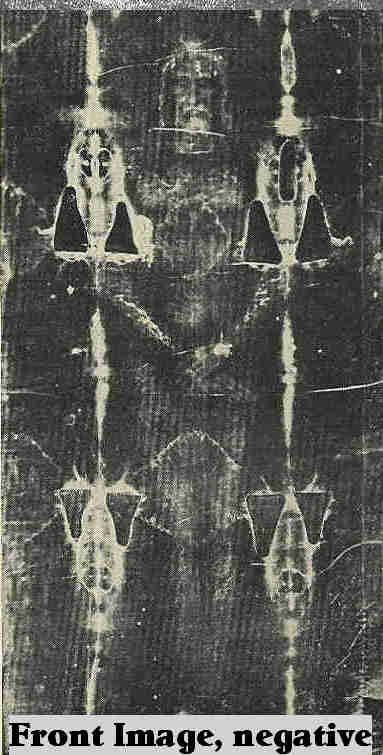
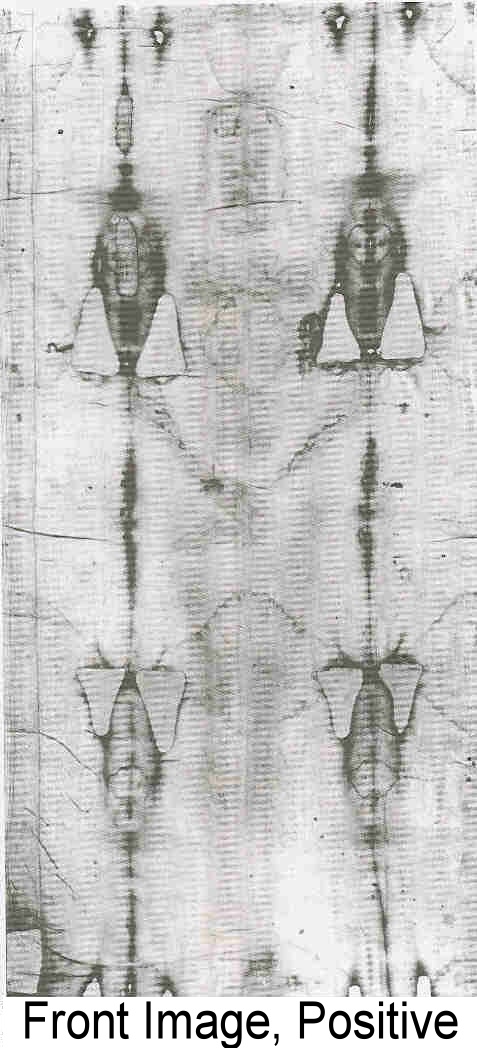
THE SHROUD
OLD
NEW EVIDENCE
We’ve used two pages going over the “old” evidence about the shroud of Turin. On the way, we demonstrated that it’s not a recent (13th century) forgery. It isn’t painted; it does contain real blood. From the image itself, to the data it contains, the shroud points to a supernatural event that describes Jesus. On this page we encounter evidence that will test even to credulity of believers. The shroud was wrapped around the body, but the image is flat. The image is not of a man lying down, but in an upright position, but not standing. Shadows on the image show that the “light” originated above the head.
Before we get into the “can’t be” things about the shroud, I’d like to quickly review the main areas we've covered. The shroud is linen about three half by 14 and half feet long. It was not wound around the body like a mummy, it was laid on the flat stone, the body was placed on top of it, and the other half was brought over the head and down to the feet. Then it was tucked in around the body using many bags of spices. The image is just many defused smudges. A careful look at the smudges reveals the form of the body. The image can only be seen on one side. The backside shows no image, even when light is shown through the shroud. The only things that show are the blood marks, which have soaked through the cloth. The first photographs of the shroud taken by Secondo Pia revealed one of the most astounding properties of the shroud. When Pia developed the negatives, he found that the negative image showed that positive coloration. Additionally this positive image included enough detail to show small to inch lash marks. This kind of detail is totally invisible to the naked eye. The fact of this negative image alone is enough evidence to prove that the shroud is not a painted forgery. Additionally, while the image is negative, the blood marks show positive. The shroud therefore contains both positive and negative images. Micrographs taking at high magnification clearly show the individual, 15 micron-thick fibers that make up each small thread of the cloth. These fibers have been structurally changed, taking on a yellowish quality in the process. These yellowed fibers make up the image of the man. The micrographs show, incredibly, that fibers laying next to each other on the same thread have not been yellowed like their next-door neighbors. One thread may have 20 individual fibers, which alternate, yellowed, not yellowed, yellowed, not yellowed, yellowed, etc. These fibers are less than a human hair in thickness! Lastly, no yellowed fibers can be found on the reverse side of any thread. All the yellowing is found only on the inside surface of the cloth, and only ONE FIBER DEEP! ! !
Now let’s get back into a Gilbert R. Lavoie’s book called “Resurrected”. He's got a few more things that I think it’s important to review.
- We know from the pollen and faint flower images that the shroud originated from Jerusalem in the spring of the year.
- Historians traced the shroud to Constantinople in 944 and tell us that there was an ancient cloth called the Image of Edessa that goes back to the first century. This ancient cloth was in the East and is said to have an image of Jesus that was “not made by the hands of man”.
- The image is complex, containing photographic information but of a three-dimensional quality, as well as x-ray-like information.
- Magnified photographs of the image demonstrate no paint and the scorched yellowness of only the top most fibers of the threads are responsible for the image. Technology to this date has not been able to reproduce this complex image at the microscopic level.
- The shading is more like the technology of newspaper print -- -- “if you want to make an area darker, you put in more dots.”
- What looks like blood has been chemically substantiated to be blood, serum is present.
- The blood came first, the image second.
New information indicates that the radiocarbon dating results are in error. The shroud can be historically dated back to the eighth century, and there is no information that tells us that the shroud could not be from the first century.
THE WRAP, THE BLOOD, THE IMAGE
Dr. Lavoie says, “Now that I knew in that the shroud blood marks were a historical possibility, I decided to pursue the study of a blood mark that had always intrigued me: the off-the-body-image blood mark located at the left elbow. I did not have an explanation as to how this blood mark got to its off-image position. I have wondered what would happen if I placed the cloth over my own body. The location of the drape surprised me. The off-the-image blood mark was touching the back of my upper arm. The whole family began working on a full-size tracing of the left arm and off image blood mark. Once the tracing was completed, we then turned it over and laid it over one of us in the same way that we felt the shroud cloth had been laid upon the body. From this direct frontal view of the man, I noted that the off image blood mark was not visible. The shroud image is similar to a direct frontal photograph a man; it shows no sides. From this information, it becomes obvious that the off image blood mark was caused by the cloth touching the clot on the back of the upper arm as the cloth draped over the side of the body. At this point in the study, I realized that the other blood marks on the image translate into two-dimensional information, corresponding to the man’s height and width. However, the off-the-image blood mark is graphic evidence pointing to yet a third dimension – depth: a three dimensional figure had been under this cloth.
The clotted blood on the back of the upper arm represents a prior blood flow that followed the force of gravity. The origin of the blood flow likely started at a wrist wound, which is not visible, and flowed down the forearm, past the elbow, and around the back of the upper arm collecting in a round pool of blood on the underside of the arm.
Once I understood the process of how the Austin H. Bud Mark was formed, I realized that this information brought me to an appreciation of the difference between the production of the blood Marx and the creation of the image
Where the cloth touched the forearm, the image of the forearm can be seen, but where the cloth touched the back of the upper arm, there is no image. Therefore, image formation had nothing to do with the cloth touching skin or sweat products. I knew that in contrast to the blood marks, the body image was not created by a contact process. If it had been, an image of the upper arm would be seen extending out as far as the off-image blood mark.
In summary, this off-image blood mark told me three things about the shroud: (1) The shroud cloth had covered a three-dimensional figure of crucified man (2). A contact process made the blood marks. (3) The image was not made by a contact process.”
And let me remind you that if the image conformed to the “wrap” of the cloth, the image would be spread out and deformed. It’s not.
FLAT AND ROUND AT THE SAME TIME???
To expand the above ideas, let’s take a closer look at the head area. Dr. Lavoie, “In 1986, I discovered something new. Over time, as I would observe the blood of the forehead and hair, I wondered if the blood came out a little too far on either side of the face and. I wondered if it were not the same phenomenon as seen at the off-image blood mark at the left elbow. Eventually I took the life-size picture of the shroud face from the wall and brought it home. I asked my daughters, Catherine and Marguerite, to outline on tracing paper the blood marks of the forehead and hair. I also asked them to trace the position of the eyes and nose. I then had Catherine make a cutout of the tracing, remove the paper within the outlined landmarks, and make holes at the eyes that would be large enough to see through. When she finished, I took her work and went to a mirror and placed the tracing paper with its cutout over my face, aligning the eyes and nose of the figure with my own. As I looked through the eyes slits at the reflection of the paper that covered my face, I was stunned by what I saw. Wanting confirmation from an objective observer regarding the reflection in the mirror, I sent the cutout to Alan Adler with the following instructions: “go to a mirror, then align and wrap the cutout on your face, and let me know what you think you are looking at.”
He called back. “When I first saw your cutout, I thought that you had finally lost your mind and had started playing with paper dolls. But I decided that I’d humor you and play along. I went to the mirror to look, and couldn’t believe what I saw. The blood is not on the hair. It’s on the sides of the face!” Allen came to the same conclusion as I had. It was as simple as cutting out paper dolls, but the information helps us to better understand the shroud.
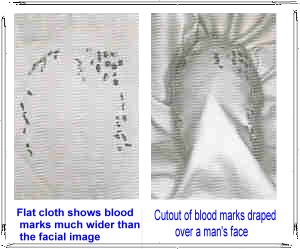 Visually reproducing this was fairly simple. All I needed was a bearded man. Rev. Dan Twomey of my own parish volunteered. So I asked him if he would lie down so that I could retake his picture in the correct position. Using my full-size photograph of the shroud face, we had already prepared another cutout of the blood marks of the face and hair, but this time we used both. I draped the cloth with the cutout of the blood marks over Father Dan’s face, aligning his eyes and nose with that of the tracing While the cloth was over his face, I applied paint to his skin through each blood mark cutout. Then I removed the cloth from his face. The painted blood marks graphically demonstrated that all the blood marks seen on the hair of the shroud image had been originally on the face. Yes, they had been on the temples and cheeks of the man who had been under the shroud area. The blood marks are consistent with the cloth having been draped and sufficiently tucked over a man’s face covered with moist clots. The transfer of blood to cloth was a simple contact process. This blood went on to the cloth before the image.
Visually reproducing this was fairly simple. All I needed was a bearded man. Rev. Dan Twomey of my own parish volunteered. So I asked him if he would lie down so that I could retake his picture in the correct position. Using my full-size photograph of the shroud face, we had already prepared another cutout of the blood marks of the face and hair, but this time we used both. I draped the cloth with the cutout of the blood marks over Father Dan’s face, aligning his eyes and nose with that of the tracing While the cloth was over his face, I applied paint to his skin through each blood mark cutout. Then I removed the cloth from his face. The painted blood marks graphically demonstrated that all the blood marks seen on the hair of the shroud image had been originally on the face. Yes, they had been on the temples and cheeks of the man who had been under the shroud area. The blood marks are consistent with the cloth having been draped and sufficiently tucked over a man’s face covered with moist clots. The transfer of blood to cloth was a simple contact process. This blood went on to the cloth before the image.
The same blood marks of the face also told me something about the facial image: the shroud cloth had been in intimate contact not only with the front of the face but also with the sides of the face. Yet despite the intimate contact that the shroud cloth had with the temples and cheeks, no images of the sides of the face are seen. In contrast, if images had been produced where the shroud cloth came in contact with the sides of the face, the resulting facial image would have been markedly distorted. The cheeks and temples would have extended out to the blood marks seen in the hair.
But the nose and cheeks of the shroud are not broadened, and the face of the shroud image is not grotesque. Rather, what you see is the frontal view of a normal face, the same frontal view that you would see of yourself in a mirror or photograph. What does the absence of the images of the sides of the shroud face mean? It means that a cloth-to-body contact process could not possibly have formed the shroud image.
I began to look at the shroud's facial image from a different point of view. I started to recognize the obvious: the temples and cheeks of the image do not exhibit the blood marks that had been on the face of the man who had been covered by the shroud. Those blood marks are now out in the hair.
What does this lack of congruence say a with regard to image formation? It says that image formation did not take place at the time that the cloth was draped over the face. It seems that the facial image was created not at the time of the draping, but at a time when the cloth was stretched out and a negative photograph of the face appeared on the flattened cloth between the blood marks. The visual information at hand tells its own story. The production of the blood marks and the formation of the body image are much more than two different phenomena each caused by a different process. They really tell us something more: (1) When the transfer of blood to cloth took place, the cloth was draped and sufficiently tucked to cause the transfer; the cloth was in one position. (2) When the image was formed, it seems that the cloth was in a second position – spread out flat. Therefore, the cloth had to have been spatially into separate positions. Events separate in space and separate in time!
For the image of the face and hair to be transferred to the cloth we have to assume that the cloth was flattened out over the body as the image was being transferred from body to cloth. As a result, it seems as if the cloth was flattened out and a negative photo was taken of the face. The blood marks, originally on the temples and cheeks of the man under the cloth, now appear to be in the hair of the image.
We have no proof that the cloth was moved. The blood-to-body alignment is perfect and indicates no movement. The blood marks tell us that this cloth was draped and sufficiently tucked to cause the blood marks that are seen. Can we assume that someone then flattened it? We cannot. Therefore we are left with a cloth that was draped over a body and somehow the image got onto the cloth in a manner that defies our normal understanding of image transfer, and defies our normal understanding of space and time. Why? Because we cannot reconcile having the same segment of cloth on two areas of the head simultaneously. We cannot reconcile that the falling hair transferred its image to that very same space of cloth that should still be on the forehead-temple areas.
This transfer of body to cloth that resulted in an image that did not follow our ordinary understanding of space and time.
Whatever form of energy that is theorized has to produce the complex image of the shroud (have all the same qualities – photo, 3-D quality, x-ray) and produce this image so that it is also the same as the shroud image at the microscopic fiber level. Furthermore, we would need evidence that this form of energy was available centuries ago.
Terms such as radiation, heat, X-radiation and auto-radiography, dematerialization, Corona discharge, photography, vaporizations, vertically collimated radiation, microbes, contact – and the list goes on – have all been used by scientists in an attempt to understand the energy source that caused this image. There is some truth that lies in some of these theories, but none have been able to produce the shroud image withall the qualities and fulfill the criteria of being the same as the shroud at the microscopic level.
In over 100 years since 1898 when Secondo Pia took the first photograph that started the search for natural causes, no one has been able to accomplish the feat of reproducing it. We do not understand the mechanics of the body-to-cloth position that accounts for a transfer of the image from body to cloth, nor do we know what the source of energy is that ultimately caused the image."
THE UPRIGHT MAN
We’ve seen a lot of evidence that is somewhat difficult to understand and much harder to believe. But Al Jolson used to say, “You ain’t seen nothing yet!” Let me remind you that the shroud hasn’t changed. The evidence available today is the same evidence that was available fifteen centuries ago. Proper focus has never been given to the hair and feet. Also, even the photo experts didn’t take into account the shadows clearly seen on the image. When investigated, the hair, feet and shadows evidence two astounding facts.
THE MAN WAS IN AN UPRIGHT POSITION WHEN THE IMAGE WAS TRANSFERRED TO THE CLOTH
THE MAN WAS “ILLUMINATED” FROM ABOVE THE HEAD
Stop for just a second and try to imagine the scene. A dead body suspended in air, brightly illuminated from above the head. Oh, and don’t forget the flattened position of the shroud. The shroud is also no longer lying horizontal.
Let’s let Dr. Lovoie detail this out for us. He’s just discovering his mistake in taking Fr. Dan’s picture lying down. He noticed a distinct deference between the shroud image and Father Dan’s image.
“As I held the negative of Dan’s face up to the lights, I was struck by the fact that his image was not similar to the shroud image. On the shroud face, there was light around the eyes, under the nose, at the lips; Dan’s face was a bland gray, with no striking differences from shades of gray as seen on the shroud image. They were not the same. What was different?"
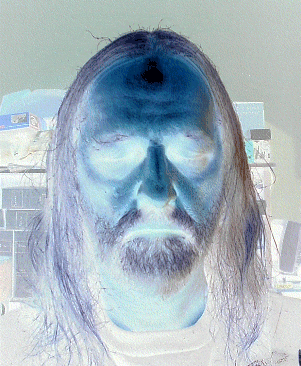
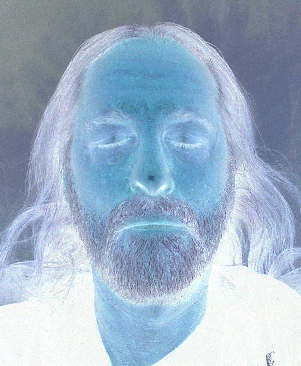 This is what the negatives of my face looked like when positioned like Father Dan's. The left hand picture is of me sitting up in a chair. The right hand image is when I was lying on the floor. Notice the distinct difference in the shadows on one shot and the blandness of the other shot. Also worth noticing is the width of my face in the two shots. The upright pose on the left shows a narrower face.
This is what the negatives of my face looked like when positioned like Father Dan's. The left hand picture is of me sitting up in a chair. The right hand image is when I was lying on the floor. Notice the distinct difference in the shadows on one shot and the blandness of the other shot. Also worth noticing is the width of my face in the two shots. The upright pose on the left shows a narrower face.
Dr. L. continues, "I began to look through all my negatives until I came across another negative of Dan’s face. In awe, I sat there. There was no denying it. The light areas around the eyes, between the lips, and under the nose are all there. Dan’s face had very similar characteristics to the shroud face except for some of the shading of the hair. This negative of Dan had been photographed differently. By mistake, I first took a picture of Dan’s face in the upright position. It was this negative of Dan’s face in the upright position that looked very much like the face of the shroud image. What appear like shadows of the shroud’s facial image, indicate that the man of the shroud is upright rather than a lying position, the position of burial."
Jax Note: You may have thought, as I did, that the upright position isn't proved by the positioning of the shadows. the only thing that looks sure is that the "light" came from the top of the head downward. This really turns out to be a quibble when we get to the part about the hair.
"But after further observation, I found other areas that appear like shadows on the shroud image. These are light areas under the hair, at the neck, under the pectoral muscles of the chest, and under the hands.
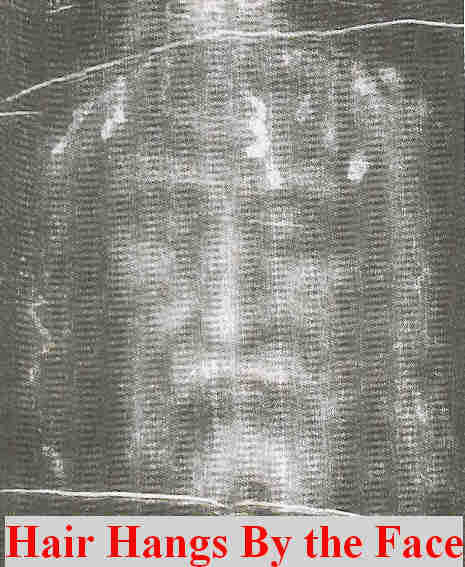
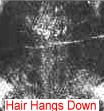 I then searched for consistency in other than what look like shadows that would correspond to an upright man. As I looked over the frontal image of the shroud, I suddenly became aware of the obvious. The hair flows down on both sides of the face following the force of gravity. Looking at the back of the image I could see that the same was true. The hair flows over the shoulders and down the back.
I then searched for consistency in other than what look like shadows that would correspond to an upright man. As I looked over the frontal image of the shroud, I suddenly became aware of the obvious. The hair flows down on both sides of the face following the force of gravity. Looking at the back of the image I could see that the same was true. The hair flows over the shoulders and down the back.
Long hair responds to gravitational force and takes on a typical appearance that is familiar to everyone. The hair of the man of the shroud is that of an upright man."
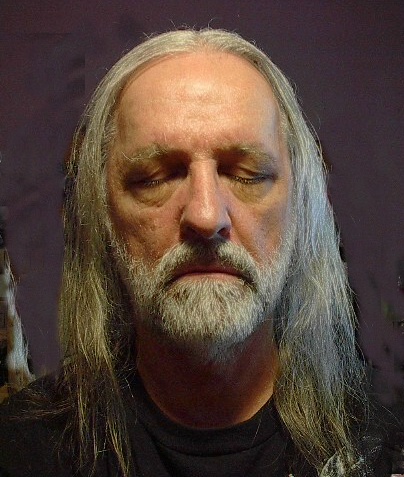
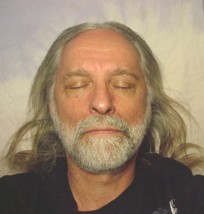
Now here's what that looks like on a real person. On the left, in the upright position, the hair is clearly hanging down. In the right picture, with me lying on the floor, there is no hair by my face at all. It's lying on the floor away from my face.
It's so interesting that all this very obvious data has never been considered before. Is it the old "forest and trees" thing? But it even happened with Dr. Lavoie. "I had been studying the shroud for eight years before I noticed these findings, and for me it is now plain as day. Why didn’t I see them before? I had been blinded by my own conviction that this was the image of a man who was laid in burial. The blood marks are consistent with that conviction. Therefore I assumed that the image was the same. I was wrong."
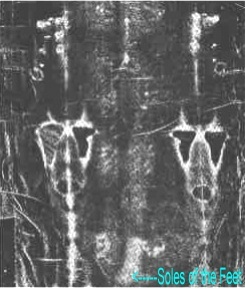
"Upright, yes, but not standing. The position of the soles of the feet indicates that the image of the man of the shroud is not in the standing position.
The upright man complicates things as much and probably more than the problem of body-to-cloth position as described earlier. How could the cloth maintain alignment with the blood marks of the man if he moved from a lying to an upright position? Where did the light come from? There are no answers to such questions because no one knows how the image was formed."
CONCLUSIONS
- The blood is real.
- The image is of a man who was crucified.
- The wounds are identical to those inflicted upon Jesus.
- The scourge marks are historically consistent.
- 99 percent of scientists world wide who has studied the cloth up close, have found that is not a painting.
- The process causing the yellowness of the top most fibers of the threads responsible for the image is unknown.
- The shading quality of the image is more like the results of modern printing technology.
- The shroud micrographs showed no residue of paint or powder.
- If the image was created by contact, it would be grotesque and distorted, with the blood marks out of alignment.
- The image is not produced by a contact process.
- The image is complex, with photographic, three-dimensional and x-ray-like qualities.
- The information indicates that this was a Jewish burial.
- The faint flower images seen on the cloth are all flowers that grow in the Holy Land. These flowers bloom in spring at Passover time.
- There are what appear to be shadows on the body image.
- The hair falls down to the shoulders and the soles of the feet are seen on the shroud.
- It appears that this dead man has been lifted from the position of burial and is now upright as if suspended in midair.
"Perhaps this experience with the shroud image may bring us back to a locked to house where a small group of men, living in fear for their very existence, were eventually vindicated by the appearance of the resurrected Jesus who is no longer constrained by space and time. Perhaps the shroud image has survived to enable a modern world to share the same boundless joy that a small group of desperate men felt 2000 years ago."
The shroud of Turin proves the supernatural. No human produced it. And isn’t it interesting that all the qualities of the shroud just happened to align with only one event in history? Everything points to Jesus.
HE IS RISEN INDEED! ! !

I love mail. 
Come Home


 Visually reproducing this was fairly simple. All I needed was a bearded man. Rev. Dan Twomey of my own parish volunteered. So I asked him if he would lie down so that I could retake his picture in the correct position. Using my full-size photograph of the shroud face, we had already prepared another cutout of the blood marks of the face and hair, but this time we used both. I draped the cloth with the cutout of the blood marks over Father Dan’s face, aligning his eyes and nose with that of the tracing While the cloth was over his face, I applied paint to his skin through each blood mark cutout. Then I removed the cloth from his face. The painted blood marks graphically demonstrated that all the blood marks seen on the hair of the shroud image had been originally on the face. Yes, they had been on the temples and cheeks of the man who had been under the shroud area. The blood marks are consistent with the cloth having been draped and sufficiently tucked over a man’s face covered with moist clots. The transfer of blood to cloth was a simple contact process. This blood went on to the cloth before the image.
Visually reproducing this was fairly simple. All I needed was a bearded man. Rev. Dan Twomey of my own parish volunteered. So I asked him if he would lie down so that I could retake his picture in the correct position. Using my full-size photograph of the shroud face, we had already prepared another cutout of the blood marks of the face and hair, but this time we used both. I draped the cloth with the cutout of the blood marks over Father Dan’s face, aligning his eyes and nose with that of the tracing While the cloth was over his face, I applied paint to his skin through each blood mark cutout. Then I removed the cloth from his face. The painted blood marks graphically demonstrated that all the blood marks seen on the hair of the shroud image had been originally on the face. Yes, they had been on the temples and cheeks of the man who had been under the shroud area. The blood marks are consistent with the cloth having been draped and sufficiently tucked over a man’s face covered with moist clots. The transfer of blood to cloth was a simple contact process. This blood went on to the cloth before the image.
 This is what the negatives of my face looked like when positioned like Father Dan's. The left hand picture is of me sitting up in a chair. The right hand image is when I was lying on the floor. Notice the distinct difference in the shadows on one shot and the blandness of the other shot. Also worth noticing is the width of my face in the two shots. The upright pose on the left shows a narrower face.
This is what the negatives of my face looked like when positioned like Father Dan's. The left hand picture is of me sitting up in a chair. The right hand image is when I was lying on the floor. Notice the distinct difference in the shadows on one shot and the blandness of the other shot. Also worth noticing is the width of my face in the two shots. The upright pose on the left shows a narrower face.
 I then searched for consistency in other than what look like shadows that would correspond to an upright man. As I looked over the frontal image of the shroud, I suddenly became aware of the obvious. The hair flows down on both sides of the face following the force of gravity. Looking at the back of the image I could see that the same was true. The hair flows over the shoulders and down the back.
I then searched for consistency in other than what look like shadows that would correspond to an upright man. As I looked over the frontal image of the shroud, I suddenly became aware of the obvious. The hair flows down on both sides of the face following the force of gravity. Looking at the back of the image I could see that the same was true. The hair flows over the shoulders and down the back.



